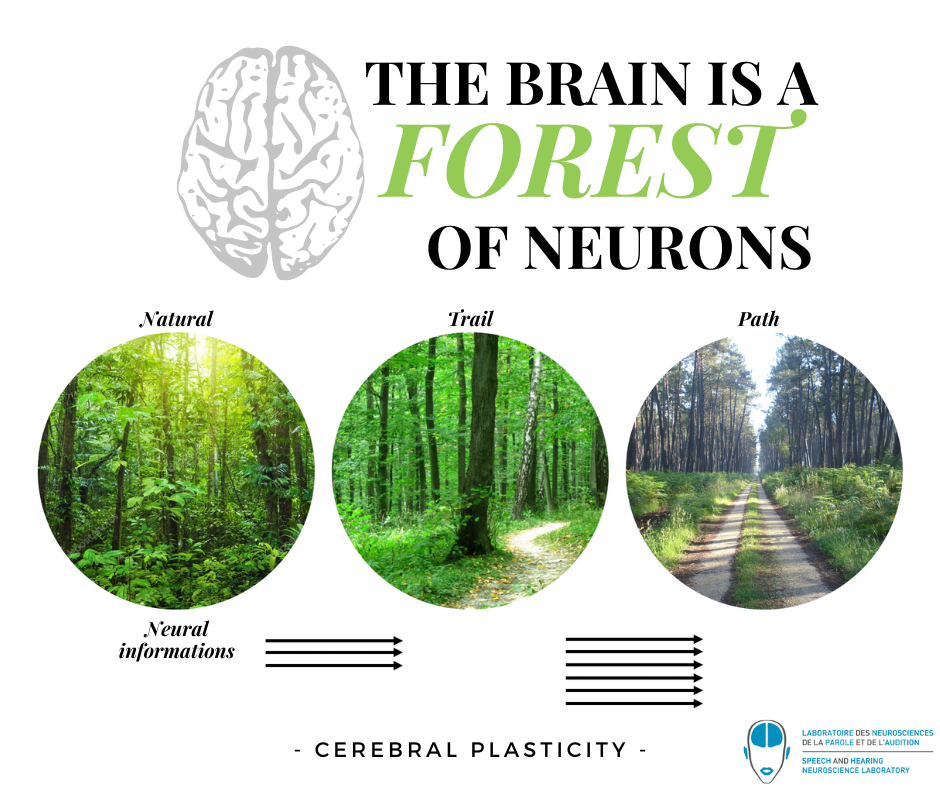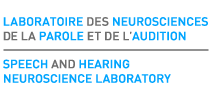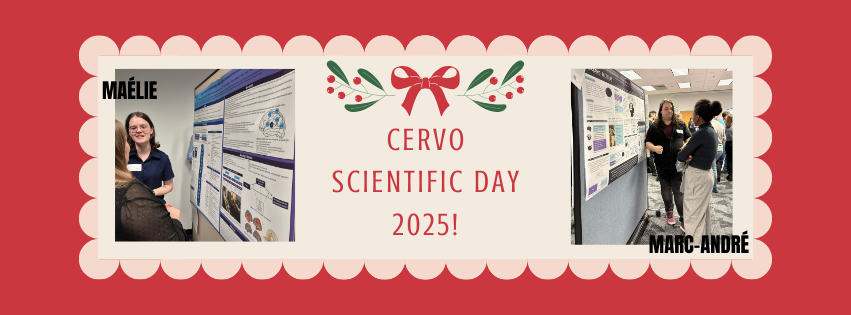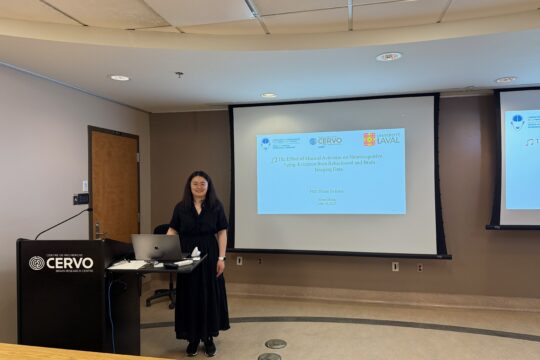Neurons have an extraordinary capacity for adaptation and reorganization! This capacity is what we call “cerebral plasticity”, “brain plasticity” or “neuroplasticity”. Plasticity is essential for our brain and it is a fundamental part of memory and learning!
It is the reason a child is able to learn how to speak and walk. But plasticity is not specific to the developing brain. It also allows adults to learn new skills such as playing a musical instrument, a new game, or learning a second language. Plasticity also occurs following physical or psychological trauma (e.g., stroke, traumatic brain injury). Thus, our experiences shape the very organization of our brain, both in its anatomy and in the ways it works.
Plasticity can be compared to the process of creating a path in a forest. Let’s imagine that neurons are trees in a forest among which information can circulate, for example, a word to remember. Repeating this word over and over to memorize it is equivalent to taking the same steps in this forest over and over again, which gradually creates a trail. As the trail emerges, the word to be remembered then becomes “engraved” in our memory. This mechanism is the same for our memories: the more we play them out, the more they widen the trail and deepen the connections between our neurons. Likewise, the more we practise physical movements, e.g., playing the violin or kicking a soccer ball, the better we get. The trail becomes a path, sometimes even a road, and intersections form, allowing new connections between neurons to appear. On the other side, unused trails eventually disappear.

Even though neuroplasticity is highest in early childhood and gradually decreases with age, it never completely disappears; allowing people of all ages to acquire new knowledge and skills!
The concept of plasticity is at the heart of the development of training methods, games, devices, and even drugs that aim to induce changes in the brain to reduce the effects of aging. But beware! Most if not all of these “brain-training” activities lack adequate scientific support. Mechanisms involved in brain plasticity are well understood yet, and the “recipes” for inducing plasticity to counter specific age effects on cognition in the long run, such as memory, attention, or the ability to perceive speech in the presence of noise, are unknown.
In our lab, we study two kinds of brain plasticity: one that is induced by brain stimulation, and another induced by the practice of activities, especially musical activities.
Plasticity induced by brain stimulation:
Transcranial magnetic stimulation (TMS) is a method used in neuroscience and is called non-invasive as it does not require any surgical intervention or cause the destruction of brain tissue. TMS can temporarily activate or deactivate specific regions of the brain. A coil generates small, brief magnetic fields called “pulses”. Depending on the stimulation parameters used (e.g., the number of pulses, the strength of the pulses and the target brain area), this magnetic field increases or decreases the activity of the stimulated neurons. TMS is used to study brain functioning and to induce plastic changes to improve speech/language, cognition, motor skills, mood and other aspects of human behaviour. This method is also used for treating symptoms associated with different brain conditions like depression or stroke-induced aphasia.
In the lab, we use TMS to study speech production, speech perception as well as cognition. For example, Valérie Brisson, a doctoral student in the lab, aims to better understand how brain aging affects speech perception in noise and to determine if TMS can induce plastic changes and reduce difficulties related to speech perception in noise during aging. In another project, Pascale and Marilyne are studying the effect of brain stimulation on brain activity using EEG in order to optimize brain stimulation paradigms and to understand the mechanisms underlying individual differences in the response to TMS.
Plasticity induced by the practice of musical activities:
Repeated training can create long-term changes in our brain which can result in improved behavioural outcomes in certain circumstances. This is because practising a musical activity is considered a global training as it involves the use of multiple senses at once. Imagine pianists. They must read musical sheets, coordinate their finger movements to press the notes, and listen to the resulting sounds to ensure that they have produced the correct ones. It is also an exercise that involves several cognitive domains: memory, concentration, and recall, e.g., reading several notes in advance. Our lab is interested in amateur musical activities, which are universal and accessible to everyone. In Quebec alone, there are more than 500,000 amateur choir singers!
In 2011, we began this line of work with a study on the effects of amateur singing on voice control (#294-2011). Our results show a beneficial effect of singing on the voice during normal aging.
We continued this line of work with two larger-scale projects.
The first project, funded by the Drummond Foundation, examined the aging of adult singers and non-singers in terms of voice control, speech production, and cognitive processes such as attention and working memory as well as brain structure and function. We collected behavioural data on over 150 people and MRI data on 85! It’s been quite a journey. Several articles have been published:
- Tremblay, P., & Perron, M. (2023). Auditory cognitive aging in amateur singers and non-singers. Cognition.
- Marczyk, A., Roy, J-P., Vaillancourt, J. Tremblay, P. (2022) Learning transfer from singing to speech: Insights from vowel analyses in aging amateur singers and non-singers. Speech Communication, 141, 28-39.
- Perron, M., Vaillancourt, J., Tremblay, P. (2022) Amateur singing benefits speech perception in aging under certain conditions of practice: behavioural and neurobiological mechanisms. Brain structure and function, 227(3):943-962
- Perron, M., Theaud, G., Descoteaux, M, *Tremblay, P. (2021) The fronto-temporal organization of the arcuate fasciculus and its relationship with speech perception in young and older amateur singers and non-singers. Human Brain Mapping.
These articles report modest effects of amateur singing on speech perception, speech production and auditory cognitive functions. We also show some associations with brain structure and functions. One important outcome of this project is that singing does not appear to be sufficient to generate string benefits. Practising frequency and having received training appears to be needed. Additional analyses are underway, specifically, Xiyue Zhang, a doctoral student in the lab, is studying resting-state networks in the cohort, and verbal fluency is being analyzed by our former postdoc Edith Durant.
We pursued this work through another major project, funded by the FRQNT, which focuses on the aging of language and cognition in healthy adults practising amateur musical activities (singing and playing a musical instrument) and in those practising a non-musical activity. This project will allow us to determine whether benefits are specific to the activity performed (singing vs. instrument playing) and whether non-musical activities can also have similar impacts. 110 people have been recruited thus far. This project has mobilized many lab members: Elisabeth Maillard, Marilyne Joyal, Lydia Gagnon, Alison Arseneault, Pascale Tremblay, Sabrina Juhasz, Alexandre Sicard and many others. Data analyses are currently underway! More soon!
Suggested readings:


